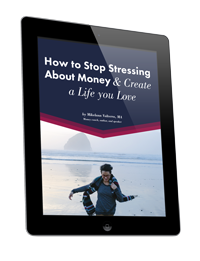Here’s a question– Did you wake up last January with a spending hangover? You know what I mean- come January, when all the gifts are opened and the parties are over, the Visa, MasterCard, Macy’s and Nordstrom’s bills begin to arrive.
Credit card use is up 7% this holiday season. And sadly, it takes the average American who uses credit cards to finance Christmas six to seven months to pay off the holidays. Who wants to be basking in the summer sunshine while still paying for the gifts you gave your kids, family and friends?
If you want to avoid that January spending hangover, consider this: at the root of post-holiday debt is lack of planning. When we don’t do prior planning, we eliminate some of our buying options.
The answer is to create a “holiday spending plan”. So find 30 minutes, print this article out, grab a cup of coffee, a pencil and a pad of paper, and help yourself avoid the Post-Holiday Spending Hangover.
8 Step Plan to Avoid the Post-Holiday Spending Hangover
Step One: Create your Columns — On a sheet of paper, create three long columns. Label the first column “people”, the middle column “gift ideas” and the last column “amount”.
Step Two: Brainstorm People — Using a pencil, create a list of all the people you are planning on giving a gift to. Don’t put down gift ideas yet. Brainstorm people. One of the biggest problems around holiday gift giving is that we end up gifting a lot more people than we originally thought about. Consider creating three lists: Family, Friends, Service Providers (babysitters etc.)
Step Three: Brainstorm Gift Ideas — Write down gift ideas. You’ve likely already thought of gift ideas for some of the people. And make sure you write down in this column all the gifts you’ve already bought!! Did you pick up gifts over the summer or already start your shopping? Write these gifts down!
Step Four: What will the Gift Cost? — Now it is time to put down amounts of money in the right hand column. Do the best you can. You’ll enter a zero where you’ve already bought the gift you wrote down.
Step Five: Add it Up — Take a deep breath and add it up. This is the total amount you are planning on spending on gifts.
Step Six: Other Holiday Spending — Part of what puts people over the edge during the season is all the extra spending on things besides gifts. Grab another piece of paper and list out the following categories, with room under each category to break it down into smaller items. Write down: Holiday parties, Holiday food, Holiday decorations, Holiday travel, Holiday clothes, Holiday gift wrap/postage. Now go fill in the details. For example, under holiday decorations you may write down a tree, new lights for the tree and a couple of poinsettias.
Step Seven: What will the Other Holiday Items Cost? — Fill in the cost of these other forms of holiday spending. How much will the tree cost? Come up with a number for the new lights, gift wrap and postage. Guess where you have to. A guess is better than leaving it blank.
Step Eight: Totaling it Up and Adjusting — Now add your total gifts and your total “other holiday spending”. How do you feel about the amount? Does this seem like a reasonable amount to spend on the holidays? Really think about this. Can you afford this? Is it worth going into credit card debt to be able to give a gift to everyone you know? What are your other options? If your total plan seems too high, go back and make some adjustments and then re-total. Keep doing this until you feel better about the total.
This is often the time when people consider getting more creative. For example, can you give a family gift instead of gifting everyone in your friend’s family? Can you decide to draw names? I used to give gifts to friends but now we all go out and enjoy a play together. This came out of doing my own first holiday spending plan. I felt a little guilty when I approached them with my idea but discovered they were all relieved.
Remember, part of creating a plan is seeing what will happen before it happens! If you don’t like what you see, take the time to work on your list.
Be prepared to take this sheet of paper, this plan, with you when you shop- fold it up and put it in your purse. The best plan does you no good if you don’t bring it with you. As you spend money, jot down the amounts on your plan. Add up what you’ve spent on a weekly basis, or more if need-be. Where are you?
Trying to stick to a plan, regardless of how successful you are with it, will cut down on impulse buying, which is a major problem during the holidays. Without a plan, people buy more things and spend more money on each item they purchase. The temptations can be overwhelming when you are out shopping.
Also, a plan lets you know when you’ve completed your shopping. It tells you when to stop— if you don’t have a finish line, you are going to keep shopping as long as the stores are open.Knowing what you want to buy and how much you want to spend, before you leave for the mall, will save you a ton of money. You will finish your shopping earlier and you will have fewer impulse buys.
You owe it to yourself to head off that infamous spending hangover. And don’t forget the best benefit of all: a spending plan cuts down on stress! You can enjoy the holidays like they were meant to be enjoyed.
Happy holidays!

2 thoughts on “8 Step Plan to avoiding the post-holiday spending hangover”
Comments are closed.